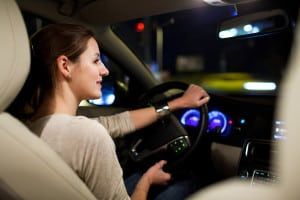 Driving at any time of day has its risks, but with nightfall comes darkness and other driving hazards that aren’t as common in the light of day. According to the National Safety Council, traffic death rates are three times greater at night than during the day, as many drivers aren’t fully aware of the unique risks of nighttime driving or don’t know how to deal with them.
Driving at any time of day has its risks, but with nightfall comes darkness and other driving hazards that aren’t as common in the light of day. According to the National Safety Council, traffic death rates are three times greater at night than during the day, as many drivers aren’t fully aware of the unique risks of nighttime driving or don’t know how to deal with them.
One of the most obvious and dangerous challenges of driving at night is darkness. According to the National Safety Council, 90 percent of our reaction time relies on vision, but darkness weakens our depth perception and peripheral vision, compromising our ability to see and react.
Fatigue is also a common hazard of nighttime driving, as drowsiness can blur your vision, dim your concentration, and slow down your reaction time. Not to mention that you risk falling asleep at the wheel. In the National Sleep Foundation’s 2005 Sleep in America poll, 60 percent of participants reported driving while feeling drowsy and 37 percent admitted to even falling asleep at the wheel in the past year.
Nighttime also brings an increase in drunk drivers, as most happy hours and alcohol-related social gatherings occur at night.
To minimize nighttime driving hazards, follow these essential tips for driving safely at night:
- Prepare your car for nighttime driving by keeping your headlights properly aimed and regularly cleaning your headlights, tail lights, signal lights, and windows
- Turn your headlights on so other drives can see you but lower them for oncoming vehicles and when you’re following another vehicle to avoid blinding the drivers
- Don’t stare at oncoming vehicles’ headlights, which can impair your vision
- Reduce your speed and increase your following distance
- Avoid driving distractions, such as texting, talking on your phone, eating, or any other activity that pulls your focus away from the road
- Stop to rest if you’re feeling too drowsy or avoid driving in the first place. If you must drive, stop frequently to stretch, walk around, or eat a light snack to stay alert
- Avoid driving at night on holidays notorious for heavy drinking, such as New Year’s Eve, St. Patrick’s Day, and Cinco de Mayo
Most importantly: Day or night, always wear a seat belt and never drink and drive.
